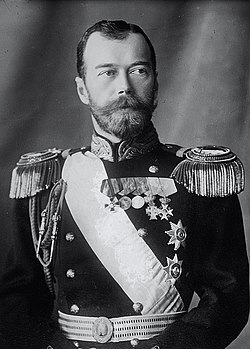Background

The killing of Nicholas II and his family in 1918 prevented royal trips from being made to Russia and the Soviet Union. [4] In 1967, when Prince Philip was asked if he would go to Moscow to help ease Cold War tensions, he said:
"I'd very much like to go to Russia - although the bastards murdered half my family". [5]
In September 1973, Prince Philip attended the European Eventing Championships in Kyiv as president of the International Equestrian Federation with his daughter, Princess Anne. [6] They became the first British royal family members to visit the Soviet Union since Nicholas II's execution. [6]
In 1989, Mikhail Gorbachev made an official visit to the United Kingdom in which he met the Queen. [7] The Queen and Gorbachev met again in July 1991 at the 17th G7 summit in London. [7] Despite this the Queen declined an invitation by Gorbachev to visit the Soviet Union. [4] Following the dissolution of the Soviet Union, Prince Charles visited Saint Petersburg in May 1994 and the Queen accepted an invitation by President Boris Yeltsin to visit the country in October 1994. [8] [4]
On 15 October 1994, Prince Charles approved Jonathan Dimbleby's biography of him titled The Prince of Wales: A Biography . [9] The book caused controversy due to Prince Charles's revelation that his father Prince Philip had pressured him into marrying Diana Spencer and that he was never in love with her. [9] Prince Charles's biography was considered to have overshadowed the visit in the British media with newspapers speculating about excerpts from the biography. [4] [10] Foreign Secretary Douglas Hurd, who would attend the visit with the Queen, said that he was worried about the way in which "chattering people concerned with headlines and mass circulation" affected institutions such as the monarchy. [9] It was reported that aides travelling with the Queen spent much of the visit playing down the controversy. [4]
In contrast, Russian media focused on the Queen and her popularity in the United Kingdom with newspaper and television coverage of the visit continuing for several days. [4] Russia was described by The Washington Post as being in the midst of a "mini-monarchist boom", with some polls showing that as many as 18 per cent of Russians favoured a return to monarchy. [4] Prince Philip said monarchy had thrived in Britain due to it being apolitical while the czar "was, by constitution, the autocrat." [4] Philip was not convinced that people in Russia would want to return to monarchies, despite the presence of monarchist parties, saying "Do the pretenders actually want to go back? Because I don't think it's an unmitigated pleasure." [4] [3]
The Prime Minister of Russia Viktor Chernomyrdin did not return as planned from a holiday in the Black Sea resort of Sochi to welcome the monarch, despite being listed in official British protocol as the one who would welcome Elizabeth II. [3] [11] Russian Minister of Foreign Affairs Andrei Kozyrev was also scheduled to greet the Queen but did not return from New York where he was attending United Nations meetings on Iraq. [11] Kozyrev was reportedly upset with his British counterpart Douglas Hurd for rejecting Russia's plans to resolve the Iraqi conflict. [3]
